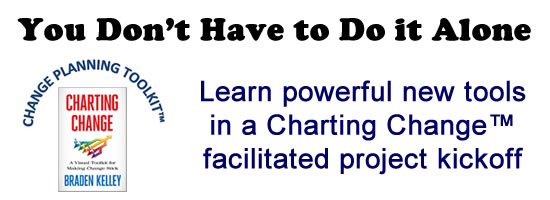Strategy Isn’t Just for the C-Suite

A significant portion of my strategy development work is with internal functions, a click or two below corporate and business unit strategy: marketing, human resources, purchasing, and even internal strategy groups.
There is good news and bad news in this. The good news is that internal functions have recognized the need to be strategic, even if it is because higher level strategies demand supporting strategies. The bad news is how many internal functions don’t think strategy applies to them.
When I ask internal functions to show me what guides their department’s work, I’m more often than not handed a plan, which is a budget in disguise. It is rarely explicit in laying out a winning aspiration with clear where-to-play and how-to-win choices.
Now, in fairness to internal functions, there is a reasonable explanation for not having a clear strategy: most internal functions have been granted what they believe is a monopoly. In other words, they do not have to worry about customers or competitors, because they think they’re the only game in town…town meaning the broader organization. Generally speaking, monopolies exist to serve themselves. The language I hear from internal functions often reveals this mentality: they almost think of the broader organization in an adversarial way…”they this” and “they that.”
Wake-up call to internal functions: you most definitely are not the only game in town. You MUST have customers other than yourselves. And if by chance your feathers are getting ruffled by internal customers demanding better value from you, know that in all likelihood you’re being considered for replacement. Ever heard of outsourcing? (business process outsourcing, BPO, is a multibillion dollar market!) Automation? Disintegration?
Internal functions should, in fact MUST think strategically. Meaning, focusing outwardly on customers and competition. The question is, how should internal functions approach crafting a strategy?
Let’s suppose we’re talking about the Human Resources group in a fictitious, rapidly expanding midsize company, GrowthSpurt, Inc., which, true to its name, is experiencing rapid growth due to a new service division launch, demanding dozens of new hires.
Sam Stickler, the SVP who heads the department, is getting complaints from both hiring managers and his own team of internal recruiters: positions are not being filled quickly enough with the right, high-quality candidates, and the recruiting team is spent, trying to respond to all the requests. Sam has a seat at the executive table, the new service division launch absolutely must be successful, so he needs a win.
Sam realizes his team is all over the map, essentially firefighting without focused priorities. He does not have an explicit strategy for handing the demands of the organization, but it’s clear that whatever they are currently doing is not going to produce the win he needs. He gathers his best thinkers to think through a strategy.
The team defines the problem simply: inability to effectively meet GrowthSpurt hiring needs due to a lack of focused priorities and an overburdened recruiting team.
Step 1: Reframe the Problem. The team reframes the problem as a choice between two mutually independent high-level options: outsourcing to a recruiting firm, or focusing their internal recruiting services…essentially a buy vs. build choice.
Step 2: Generate Possibilities. The team uses these two options to brainstorm and generate a dozen where-to-play/how-to-win possibilities.
For outsourcing, the possibilities generated run to a central theme of handing off some or all of the recruiting. There are many more possibilities for creating focus, though, including teaching hiring managers to do their own recruiting, designating recruiters to specific needs, creating special S.W.A.T.-like “strike” teams to handle critical and urgent hires, handling the squeakiest wheel first, focusing on the highest level positions only, or focusing on the positions most in need by the service business end-users.
Step 3: Select Strategic Themes. The team doesn’t find the outsourcing route attractive, as it builds no long-term capability. They decide that two different strategies for focusing recruiting services should be explored. One is a centralized recruiting strategy, requiring developing a clear approach to prioritization. The other is a decentralized recruiting strategy, requiring an approach to building recruiting capability among key hiring managers within the new service division. They nickname the first strategy S.W.A.T., and the second strategy DEVELOP.
Both potential strategies are then developed using the Playing to Win framework:
- Winning aspiration
- Where to play
- How to win
- Critical capabilities
- Required systems
For illustration purposes, let’s look at just the S.W.A.T. strategy.
Step 4: Winning Aspiration. The SWAT winning aspiration is defined as “to become a highly effective recruiting partner for GrowthSpurt with the ability to identify and hire the highest quality candidate within an informal service-level agreement (SLA) period of 15 working days.” This represents a three-fold improvement, and rivals the promise of the leading outside recruiting firm.
Step 5: Where to Play. Where-to-play spaces include hiring managers as internal customer segments with the most business-critical needs: Sales, Client Support, and Marketing. The “channel” is direct partnership and collaboration.
Step 6: How to Win. The how-to-win is the innovative essence of the SWAT approach: the best recruiters with the deepest specific subject matter knowledge in the need area swarm the position to be filled in a compressed time period in close partnership with the hiring manager.
Step 7: Critical Capabilities. Capabilities and activities needed to be performed at the highest level in order to produce the how-to-win advantage include: candidate persuasion, internal relationship-building with hiring managers, project agility, hiring needs-finding, and close collaboration.
Step 8: Required Systems. The management systems required to support and sustain the critical capabilities at the highest level include: a unique talent identification database, candidate attraction methodology, and streamlined onboarding process.
Step 9: Reverse Engineer. The team then reverse engineers the strategy by asking “what must be true” to identify the assumptions and conditions under which the S.W.A.T. strategy would be a good set of choices and most likely lead to success.
Step 10: Strategic Test. Of the several assumptions identified, the one that is most worrisome to the team, the one least likely to be true, is: “we can recruit as or more effectively as an outside recruiting firm.”
That’s where the team must start testing the strategy.
This type of strategic approach is what the best-in-breed organizations rely on to support and sustain their corporate and business unit strategies and move their business forward.
Does yours?
Wait! Before you go…
Choose how you want the latest innovation content delivered to you:
- Daily — RSS Feed — Email — Twitter — Facebook — Linkedin Today
- Weekly — Email Newsletter — Free Magazine — Linkedin Group
 Matthew E. May is the author, most recently, of Winning the Brain Game: Fixing the 7 Fatal Flaws of Thinking.
Matthew E. May is the author, most recently, of Winning the Brain Game: Fixing the 7 Fatal Flaws of Thinking.
NEVER MISS ANOTHER NEWSLETTER!
LATEST BLOGS
How Brexit Has Affected UK E-commerce Businesses
Photo by Zyro on Unsplash The popularity of online shopping was already growing at an impressive rate – and…
Read MoreOvercoming range anxiety: three tips for EV owners
Photo by Jenny Ueberberg on Unsplash In the last few years, electric vehicles (EVs) have become more and more…
Read More


